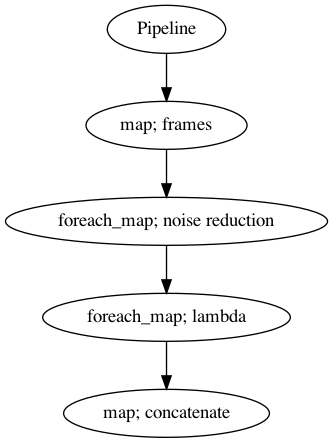Noise Reduction
Contents
Noise Reduction#
Reduce background musics, noises and etc while maintain voice activities.
This tutorial is available as an IPython notebook at malaya-speech/example/noise-reduction.
This module is language independent, so it save to use on different languages. Pretrained models trained on multilanguages.
This is an application of malaya-speech Pipeline, read more about malaya-speech Pipeline at malaya-speech/example/pipeline.
Dataset#
Trained on English, Manglish and Bahasa podcasts with augmented noises, gathered at https://github.com/huseinzol05/malaya-speech/tree/master/data/podcast
[1]:
import malaya_speech
import numpy as np
from malaya_speech import Pipeline
[2]:
y, sr = malaya_speech.load('speech/podcast/SKOLAR.wav', sr = 44100)
len(y), sr, len(y) / sr
[2]:
(2628043, 44100, 59.59281179138322)
So total length is 60 seconds.
[3]:
import IPython.display as ipd
ipd.Audio(y[:10 * sr], rate = sr)
[3]:
This audio extracted from https://www.youtube.com/watch?v=blaIfSWf38Q&t=25s&ab_channel=SkolarMalaysia
As you can hear, the audio got introduction music overlapped with speakers. So we want to reduce that introduction music and possibly split the audio into voice and background noise.
List available deep model#
[4]:
malaya_speech.noise_reduction.available_model()
INFO:root:Only calculate SDR, ISR, SAR on voice sample. Higher is better.
[4]:
| Size (MB) | Quantized Size (MB) | SUM MAE | MAE_SPEAKER | MAE_NOISE | SDR | ISR | SAR | |
|---|---|---|---|---|---|---|---|---|
| unet | 78.9 | 20.0 | 0.862316 | 0.460676 | 0.40164 | 9.173120 | 13.92435 | 13.20592 |
| resnet-unet | 96.4 | 24.6 | 0.825350 | 0.438850 | 0.38649 | 9.454130 | 13.96390 | 13.60276 |
| resnext-unet | 75.4 | 19.0 | 0.811020 | 0.447190 | 0.36383 | 8.992832 | 13.49194 | 13.13210 |
Load deep model#
def deep_model(model: str = 'resnet-unet', quantized: bool = False, **kwargs):
"""
Load Noise Reduction deep learning model.
Parameters
----------
model : str, optional (default='wavenet')
Model architecture supported. Allowed values:
* ``'unet'`` - pretrained UNET.
* ``'resnet-unet'`` - pretrained resnet-UNET.
* ``'resnext'`` - pretrained resnext-UNET.
quantized : bool, optional (default=False)
if True, will load 8-bit quantized model.
Quantized model not necessary faster, totally depends on the machine.
Returns
-------
result : malaya_speech.model.tf.UNET_STFT class
"""
[14]:
model = malaya_speech.noise_reduction.deep_model(model = 'resnet-unet')
Load Quantized deep model#
To load 8-bit quantized model, simply pass quantized = True, default is False.
We can expect slightly accuracy drop from quantized model, and not necessary faster than normal 32-bit float model, totally depends on machine.
[15]:
quantized_model = malaya_speech.noise_reduction.deep_model(model = 'resnet-unet', quantized = True)
WARNING:root:Load quantized model will cause accuracy drop.
Important factor#
Noise Reduction model trained on 44k sample rate, so make sure load the audio with 44k sample rate.
malaya_speech.load(audio_file, sr = 44100)
librosa.load(audio_file, sr = 44100)
You can feed dynamic length of audio, no need to cap, the model do padding by itself. But again, the longer the audio, the longer time required to calculate, unless you have GPU to speed up.
STFT and Inverse STFT can be done on GPU level, so the model is really fast on GPU.
[7]:
%%time
output = model(y)
CPU times: user 27.3 s, sys: 3.48 s, total: 30.8 s
Wall time: 6.54 s
[8]:
output
[8]:
{'voice': array([ 7.4655384e-07, -5.3525662e-07, -3.8191757e-07, ...,
-3.0058224e-02, -2.9105157e-02, -2.1171883e-02], dtype=float32),
'noise': array([-4.3224041e-08, -2.3430280e-06, -3.2800205e-07, ...,
-1.3801644e-03, -3.3497461e-03, -1.9985531e-03], dtype=float32)}
[9]:
ipd.Audio(output['voice'][:10 * sr], rate = sr)
[9]:
[10]:
ipd.Audio(output['noise'][:10 * sr], rate = sr)
[10]:
Nicely done! How about our quantized model?
[11]:
%%time
output_quantized = quantized_model(y)
output_quantized
CPU times: user 28.6 s, sys: 3.58 s, total: 32.2 s
Wall time: 8.05 s
[11]:
{'voice': array([ 6.0242473e-07, -6.7520131e-07, -4.9965337e-07, ...,
-3.0453464e-02, -2.9502867e-02, -2.1368120e-02], dtype=float32),
'noise': array([ 1.01274054e-07, -2.20296351e-06, -2.10108894e-07, ...,
-9.84926941e-04, -2.95203505e-03, -1.80230662e-03], dtype=float32)}
[12]:
ipd.Audio(output_quantized['voice'][:10 * sr], rate = sr)
[12]:
[13]:
ipd.Audio(output_quantized['noise'][:10 * sr], rate = sr)
[13]:
Use Pipeline#
Incase your audio is too long and you do not want to burden your machine. So, you can use malaya-speech Pipeline to split the audio splitted to 15 seconds, predict one-by-one and combine after that.
[16]:
p = Pipeline()
pipeline = (
p.map(malaya_speech.generator.frames, frame_duration_ms = 15000, sample_rate = sr)
.foreach_map(model)
.foreach_map(lambda x: x['voice'])
.map(np.concatenate)
)
p.visualize()
[16]:

[17]:
%%time
results = p.emit(y)
CPU times: user 34.8 s, sys: 4.52 s, total: 39.3 s
Wall time: 7.67 s
[18]:
results.keys()
[18]:
dict_keys(['frames', 'noise-reduction', '<lambda>', 'concatenate'])
[19]:
ipd.Audio(results['concatenate'][:10 * sr], rate = sr)
[19]:
Reference#
Wave-U-Net: A Multi-Scale Neural Network for End-to-End Audio Source Separation, Daniel Stoller, Sebastian Ewert, Simon Dixon, https://arxiv.org/abs/1806.03185
SKOLAR MALAYSIA PODCAST, https://www.youtube.com/watch?v=blaIfSWf38Q&t=25s&ab_channel=SkolarMalaysia
